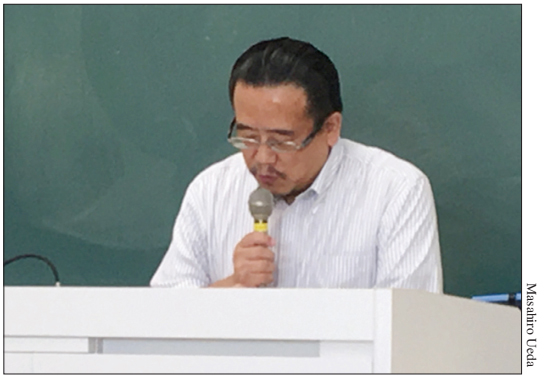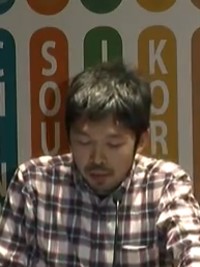
Centre of Jaina Studies Newsletter: SOAS - University of London
The 68th Annual Conference of the Japanese Association of Indian and Buddhist Studies (JAIBS) was held at Hanazono University in Kyoto on 2-3 September 2017. In this conference, five papers on Jainism were presented.
In "The Criteria for hiṃsā and ahiṃsā in Jainism," Tomoyuki Uno (Chikushi Jogakuen University) revealed the history of discussion of the criteria for hiṃsā and ahiṃsā, examining the description in commentaries of Śvetāmbara Jaina scriptures. According to him, an important criterion for determining whether an act is recognized as hiṃsā or not is based on arguments in Niryuktis and Bhāṣyas, which were written in verse during the 5th through 7th centuries. He focused on discussions in Bhadrabāhu's Niryuktis and pointed out that criteria for hiṃsā are closely related to the state of the mind of the one who engaged in the act. He examined the Bṛhatkalpabhāṣya by Saṅghadāsa, the Viśeṣāvaśyakabhāṣya by Jinabhadra and the Hiṃsāphalāṣṭaka by Haribhadra and detailed the historical evolution of discussion on the criteria.
Kazuyoshi Hotta (Otani University) read a paper entitled "Are pṛthivī, āp, tejas and vāyu alive? Reexamining an Animistic Aspect of Jainism." He reviewed the perception of Jainism as animism, as represented, for instance, by H. Jacobi, and also the criticism against it in previous research. According to Hotta, a problem in the view of Jainism as animism is that it is based on the idea that animism is based on conceptions from prior centuries. This point has not been focused on in previous studies so far. He pointed out that this idea is influenced by the theory of cultural evolutionism, which regards animism as the earlier phase in the development of religions. However, cultural evolutionism is hardly accepted today. Therefore, he concluded that there is room for reconsideration of the perception of Jainism as animism, which derives from cultural evolutionism

Tomoyuki Uno (Chikushi Jogakuen University)
In "Haribhadra on the Affirmation of kāma 'Sexual Appetite'," Yutaka Kawasaki (University of Tokyo) focused on a controversy over kāma in the Dharmasaṅgrahaṇi by Haribhadra. Kawasaki pointed out the possibility that, in this work, the subject of criticism of those who affirm kāma is not directed at people who live their life according to the view of life of Brahmanism, but to those belonging to his own Śvetāmbara sect, who were more tolerant of kāma. Kawasaki argued that this is because Haribhadra's primary concern is not the offence of the sexual intercourse of lay people of other traditions, but that of Śvetāmbara monks

Participants of the 32nd Conference of the Society for Jaina Studies at Hanazono University
In "A Change of the Neminātha Story: From Carita to Bārahmāsā," Tomoyuki Yamahata (Hokkaido University of Science) discussed differences of the episodes that appeared in the Neminātha stories and the historical transition of the Jain tales from the sixth century to the thirteenth century. He mainly focused on the characteristic of Rājal, a fiancée of Neminātha, who appears in these narratives. According to him, the Neminātha stories can be categorized into three major stages from the historical point of view. The first one deals mainly with episodes concerning Ratanemi, Nemi's brother, the second one mainly with the life of Kṛṣṇa, who is Nemi's cousin, and the last one with the mourning of Rājal's separation. In "An Example of the Deities and Rituals in the Gotras of Jainas: Mūrtipūjaka in Punjab," Akiko Shimizu (The Nakamura Hajime Eastern Institute) reported on her fieldwork on the deities and the rites amongst Jainas which was carried out in 2017 in Dehli and Ludhiana. She focused on the gotras of Mūrtipūjaka Śvetāmbaras belonging to the Śrī Ātmānanda Jain Sabhā. According to her, the characteristic of deities of gotras in Punjab is that they worship their ancestors as deities. There are rituals for the deities of gotras mainly in daily life, in every season, in every year, at an initiation ceremony and what is done on special occasions such as yātrā. She pointed out that they differed from gotra to gotra.
32nd Conference of the Society for Jaina Studies
On 30 September 2017 the 32nd Conference of the Society for Jaina Studies was held at Ōtani University, Kyoto. Three papers were read at this conference. In "On the Two Types of Exile from Gana in the Bṛhatkalpasūtra IV 2-3," Yumi Fujimoto (Tohokugakuin Tsutsujigaoka High School) examined in detail the difference between demotion (anavasthāpya) and exclusion (pārāñcita), which are respectively the 9th and 10th atonements defined in the Bṛhatkalpasūtra IV 2-3 and its commentaries. According to Fujimoto, the periods imposed for atonement are common in both. Another common point is that these atonements will be lifted if ordered by a king. In the case of anavasthāpya, the monks who are accepting it will cohabit with other members in their gaṇnaṇa. However, in the case of pārāñcita, they must go outside their gaṇnaṇa. This is one of the most significant differences seen in both atonements. In addition, Fujimoto pointed out that a verse that defines anavasthāpya in the Bṛhatkalpabhāṣya appears in the context that defines both anavasthāpya and pārāñcita in the Vyavahārabhāṣya.
In "Minakata Kumagusu and Jainism," Tomoyuki Uno (Chikushi Jogakuen University) clarified a part of the history of Jainism in Japan. Minakata Kumagusu was a famous Japanese biologist, naturalist and ethnologist who lived in the late 19th to early 20th centuries. In some previous studies, he has been regarded as highly appreciative of Jainism and its ahiṃsā from a biological point of view. Uno carefully traced the source of this perception and also examined the work of Minakata in detail. He revealed that there is no basis for this view and concluded that Minakata Kumagusu knew Jainism in fact, but did not appreciate Jainism highly. In "Dhammapada 160 and Jainism Scriptures," Kenji Watanabe (Taishō University) examined the meaning of nātha in detail, based on previous research and similar expressions in other texts. According to him, it is well known that the 160th verse of the Dhammapada shares common parts with the 380th verse. Few Indologists have mentioned the similarities to phrases in the Bhagavadgītā VI, 5. Watanabe also pointed out that there is another example in the Uttarādhyayanasūtra (Utt.) XX, 35. He also examined the expression in the Utt. XX, 12 and the Manusmṛti VIII, 84 and concluded that the meaning of nātha is "the Lord."
Masahiro Ueda is a PhD candidate at Kyoto University. His dissertation centres on the study of the exegetical literature of the Śvetāmbara Jainas. He is currently an adjunct lecturer at Kyoto University, and is presently editing the unpublished text of the Cūrṇi commentary on the Vyavahārabhāṣya.
 Masahiro Ueda
Masahiro Ueda